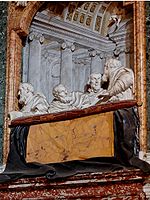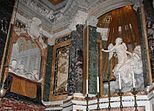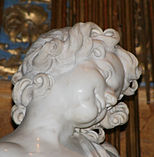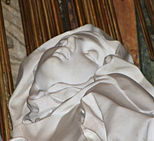Ecstasy of Saint Teresa
| Ecstasy of Saint Teresa | |
|---|---|
 | |
 Click on the map for a fullscreen view | |
| Artist | Gian Lorenzo Bernini |
| Year | 1647–1652 |
| Catalogue | 48 |
| Type | Sculpture |
| Medium | Marble |
| Dimensions | Life-size |
| Location | Santa Maria della Vittoria, Rome |
| 41°54′17″N 12°29′39″E / 41.90472°N 12.49417°E | |
| Preceded by | Raimondi Chapel |
| Followed by | Truth Unveiled by Time (Bernini) |
The Ecstasy of Saint Teresa (also known as Saint Teresa in Ecstasy;
The ensemble includes at the sides two sets of
Commission
The entire ensemble was overseen and completed by a mature Bernini during the
Cornaro had chosen the hitherto unremarkable church of the
A small format terracotta model of about 47 cm (19 in) was created between 1644 and 1647. The sculpture represents the first embodiment of the project, with traces of Bernini's fingerprints still visible. The model belongs to the Hermitage Museum's collection.[4]
Sculptural group and its setting
I saw in his hand a long spear of gold, and at the iron's point there seemed to be a little fire. He appeared to me to be thrusting it at times into my heart, and to pierce my very entrails; when he drew it out, he seemed to draw them out also, and to leave me all on fire with a great love of God. The pain was so great, that it made me moan; and yet so surpassing was the sweetness of this excessive pain, that I could not wish to be rid of it. The soul is satisfied now with nothing less than God. The pain is not bodily, but spiritual; though the body has its share in it. It is a caressing of love so sweet which now takes place between the soul and God, that I pray God of His goodness to make him experience it who may think that I am lying.[5]
The group is illuminated by natural light which filters through a hidden window in the dome of the surrounding aedicule, and underscored by gilded stucco rays. Teresa is shown lying on a cloud indicating that this is intended to be a divine apparition we are witnessing. Other witnesses appear on the side walls; life-size
The art historian Rudolf Wittkower wrote:
In spite of the pictorial character of the design as a whole, Bernini differentiated between various degrees of reality, the members of the Cornaro Chapel seem to be alive like ourselves. They belong to our space and our world. The supernatural event of Teresa's vision is raised to a sphere of its own, removed from that of the beholder mainly by virtue of the isolating canopy and the heavenly light.[6]
- Gallery
Interpretations
The effects are theatrical,
Criticism
The sexual implications of the work have not gone unnoticed. It is considered "decidely risqué";[12] "the most astounding peep show in art";[13] and "the grossest and most offensive example of Baroque art."[14] The reason for its popularity "has a lot to do with sex."[15][16] And by placing the sculpture in a theatrical setting, Bernini is accused of turning "a private moment into a very public spectacle."
Scholars who defend it against such criticism take one of three approaches, saying:
- Bernini faithfully followed Teresa’s description of the experience.
- The Church accepted that mystical union often involved erotic elements.
- There is no nudity in the statue.[19]
But Franco Mormando says "none of these defenses are completely accurate".[11] Simon Schama agrees: "Critics and scholars tie themselves in knots, trying to avoid stating the obvious."[20]
Similar works by Bernini
- See also entry titled Bernini's Cornaro chapel found in the Baroque section.
- Death of the Blessed Ludovica Albertoni (1671–1674)—San Francesco a Ripa, Rome.
- Martyrdom of Saint Lawrence (1614–15)[21]
- Truth Unveiled by Time (1646–1652) – Galleria Borghese, Rome.[22]
Influencing or influenced works
- St Cecilia in namesake church(1600).
- Melchiorre Caffà's Santa Rose of Lima (1665) and his Assumption of St Catherine.
- Francisco Aprile and namesake churchin Rome.
- The most internationally successful Czech underground group the Ecstasy of Saint Theresa named themselves after the sculpture.
- Angels & Demons, the novel by Dan Brown which lists the sculpture as the third "Altar of Science" of the fictionalized Illuminati. Brown's book incorrectly states that the sculpture was moved from the Vatican to its current location, and that Pope Urban VIII (who was already deceased when Bernini worked on the sculpture) found the statue too sexually explicit.[23]
- The sculpture is the subject of the song "The Lie" from the Peter Hammill album The Silent Corner and the Empty Stage.[24]
- In Infinite Jest by David Foster Wallace, the sculpture plays a role in the filmography of James O. Incandenza, Jr. Wallace also alludes to it in three additional scenes involving Joelle.[25]
- Street artist Banksy used the image of Saint Teresa in one of his works, though he removed the angelic figure and added a fast food meal.[26]
- The sculpture and its image are frequently referred to in the novel Cutting for Stone by Abraham Verghese.
- In the psychoanalytic theories of Jacques Lacan, the statue plays an important role due to a central reference in his book Seminar XX: Encore. Lacan believes the statue helps convey his theory of the possibility of a female enjoyment that is infinite and unknowable, while masculine enjoyment is defined by finitude and failure. Some book covers of Seminar XX have a picture of the statue on the front.
See also
References
- Notes
- Citations
- OEDdescribes "transverberation" as obselete in English, with only one usage, in the 1880s. It means piercing through the breast, as Teresa describes in her vision.
- ^ Boucher 1998, p. 135
- ^ "Italian Baroque Sculpture : Books : Thames & Hudson". Archived from the original on 28 December 2005. Retrieved 23 October 2005.
- ^ Hermitage Museum, The State. "The Ecstasy of St Teresa". Hermitage Museum. Archived from the original on 20 May 2021. Retrieved 24 March 2021.
- Teresa of Avila(1515–1582). The Life of Teresa of Jesus. Chapter XXIX; Part 17.
- ^ Wittkower, Rudolf (1980). Art and Architecture in Italy 1600–1750, Pelican History of Art. p. 160.
- ISBN 978-0-534-64237-2.
- ^ "Bernini, Ecstasy of Saint Teresa". Khan Academy. Archived from the original on 15 June 2010. Retrieved 12 February 2010.
- ^ "Caroline Babcock". academia.edu.[permanent dead link]
- ^ Boucher 1998, p. 138
- ^ S2CID 265241431.
- ^ https://www.telegraph.co.uk/travel/destinations/europe/italy/rome/attractions/santa-maria-della-vittoria/; Santa Maria della Vittoria Lee Marshall, DESTINATION EXPERT; 5 February 2016
- ^ a b Bowden, Alana Louise (2001). "The Saint Behind the Sculpture: (Re)Interpreting Saint Teresa's Ecstasy through a Feminist Analysis of Bernini's The Ecstasy of Saint Teresa". Literature & Aesthetics. 31 (1): 132–147. Retrieved 22 January 2024.
- ISBN 978-0-8165-2840-0.; A Gift of Angels: The Art of Mission San Xavier del Bac (Southwest Center Series) by Bernard L. Fontana and Edward McCain | 20 Sept 2010, page 236
- ISBN 978-1-58044-272-5.
- ProQuest 2827703947.
- ^ https://arts.unl.edu/images/art/Awards/2020_Spring/Antje_Anderson.pdf
- ^ https://www.robertspublications.com/blog/a-furlough-in-rome-part-two
- ^ https://www.tandfonline.com/doi/full/10.1080/02666286.2023.2180931; Did Bernini’s Ecstasy of St. Teresa cross a seventeenth-century line of decorum? by Franco Mormando
- ISBN 9780563487104.
- ^ "Web Gallery of Art, image collection, virtual museum, searchable database of European fine arts (1000–1900)". wga.hu.
- ^ "Truth Unveiled by Time". Official Site Borghese Gallery Bernini. Archived from the original on 25 October 2005.
- ^ Olson, Carl (4 January 2009). "Dan Brown Rushes In Where Angels (and Demons) Fear to Tread". Catholic Answers. Retrieved 13 January 2024.
- ^ "The Lie (Bernini's Saint Theresa) de Peter Hammill". Archived from the original on 25 April 2012. Retrieved 20 October 2011.
- ^ "A Field Guide to Occurrences of Bernini's Ecstasy of St. Teresa in Infinite Jest – Infinite Detox". Infinite Detox. 20 August 2009.
- ^ "Banksy". banksy.co.uk. Archived from the original on 21 October 2007.
- Sources
- Hibbard, Howard (22 January 1971). Bernini. [Baltimore] Penguin Books.
- Robert Harbison (2000). "The Case for Disruption". Reflections on Baroque. The University of Chicago Press. pp. 1–32.
- Boucher, Bruce (1998). Thames & Hudson, World of Art (ed.). Italian Baroque Sculpture. pp. 134–143. Archived from the original on 28 December 2005.
- Bernini biography (click on Ecstasy of St Teresa)
- Cocke, Richard (August 1972). "A Drawing by Bernini for the Cornaro Chapel, S. Maria della Vittoria". The Burlington Magazine. 114 (833). The Burlington Magazine Publications Ltd.: 550–553. JSTOR 877068.
External links
| External videos | |
|---|---|
 Media related to Ecstasy of Saint Theresa of Avila by Bernini at Wikimedia Commons
Media related to Ecstasy of Saint Theresa of Avila by Bernini at Wikimedia Commons
| Preceded by Ludovisi Battle sarcophagus |
Landmarks of Rome Ecstasy of Saint Teresa |
Succeeded by Raphael Rooms |





